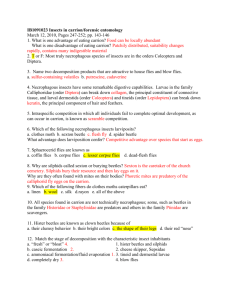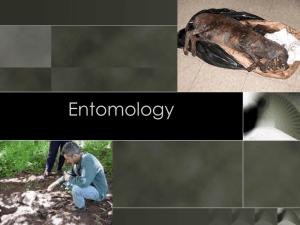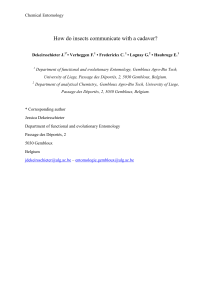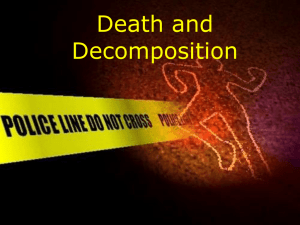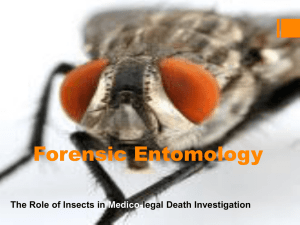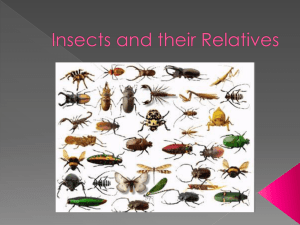Entomology Lecture
advertisement
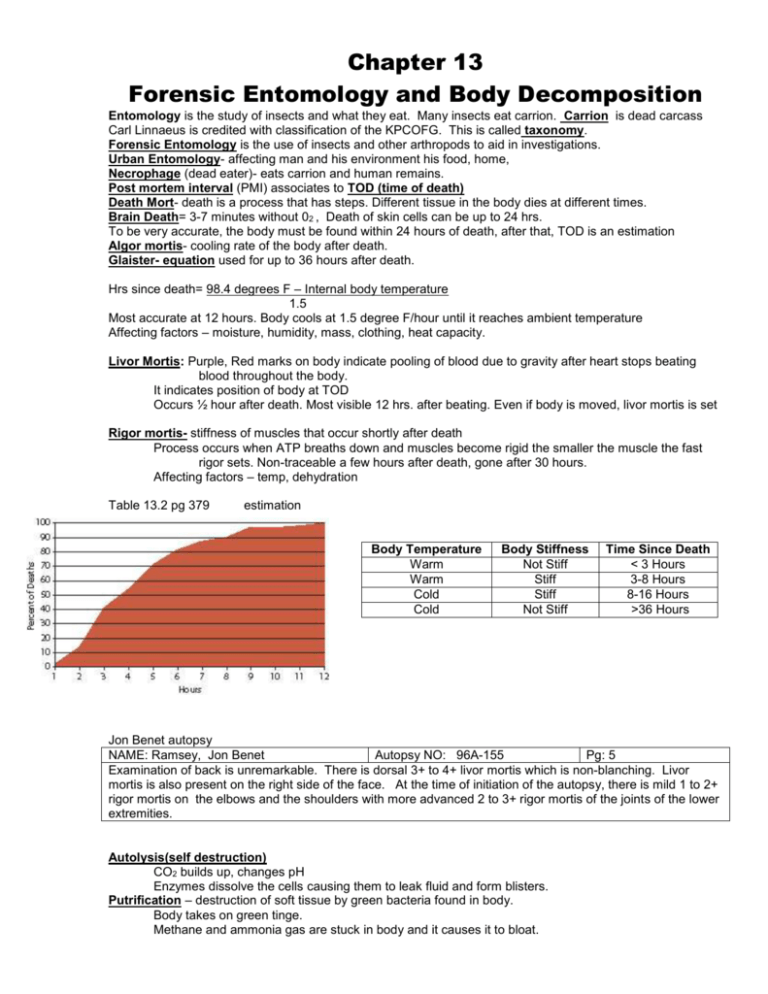
Chapter 13 Forensic Entomology and Body Decomposition Entomology is the study of insects and what they eat. Many insects eat carrion. Carrion is dead carcass Carl Linnaeus is credited with classification of the KPCOFG. This is called taxonomy. Forensic Entomology is the use of insects and other arthropods to aid in investigations. Urban Entomology- affecting man and his environment his food, home, Necrophage (dead eater)- eats carrion and human remains. Post mortem interval (PMI) associates to TOD (time of death) Death Mort- death is a process that has steps. Different tissue in the body dies at different times. Brain Death= 3-7 minutes without 02 , Death of skin cells can be up to 24 hrs. To be very accurate, the body must be found within 24 hours of death, after that, TOD is an estimation Algor mortis- cooling rate of the body after death. Glaister- equation used for up to 36 hours after death. Hrs since death= 98.4 degrees F – Internal body temperature 1.5 Most accurate at 12 hours. Body cools at 1.5 degree F/hour until it reaches ambient temperature Affecting factors – moisture, humidity, mass, clothing, heat capacity. Livor Mortis: Purple, Red marks on body indicate pooling of blood due to gravity after heart stops beating blood throughout the body. It indicates position of body at TOD Occurs ½ hour after death. Most visible 12 hrs. after beating. Even if body is moved, livor mortis is set Rigor mortis- stiffness of muscles that occur shortly after death Process occurs when ATP breaths down and muscles become rigid the smaller the muscle the fast rigor sets. Non-traceable a few hours after death, gone after 30 hours. Affecting factors – temp, dehydration Table 13.2 pg 379 estimation Body Temperature Warm Warm Cold Cold Body Stiffness Not Stiff Stiff Stiff Not Stiff Time Since Death < 3 Hours 3-8 Hours 8-16 Hours >36 Hours Jon Benet autopsy NAME: Ramsey, Jon Benet Autopsy NO: 96A-155 Pg: 5 Examination of back is unremarkable. There is dorsal 3+ to 4+ livor mortis which is non-blanching. Livor mortis is also present on the right side of the face. At the time of initiation of the autopsy, there is mild 1 to 2+ rigor mortis on the elbows and the shoulders with more advanced 2 to 3+ rigor mortis of the joints of the lower extremities. Autolysis(self destruction) CO2 builds up, changes pH Enzymes dissolve the cells causing them to leak fluid and form blisters. Putrification – destruction of soft tissue by green bacteria found in body. Body takes on green tinge. Methane and ammonia gas are stuck in body and it causes it to bloat. Smell is awful due to chemicals found called putrescine, cadaverine, skatole, methyl-disulfide Case. Actual Mrs. Sterk May 19th (her birthday ) 1992 - check on relative she had not heard from in a week. - awful smell in house - leakage of body - green/ gray color of body - huge bloating (double actually size) - nude except for underwear - vomit on nightgown - newspapers on porch dated May 15 – May 19 - watch too tight How long had the relative been dead? Adipocere- grave wax – yellow substance due to saponification (fat turned to wax) Usually occurs in moist alkaline soil High body fat Buried in a casket in a vault Mummy - dehydration of tissue - lower body fat - hot dry conditions - may occur as soon as one month after death Diagenesis – bone is chemically altered due to moisture and pH Decompositon rate has many factors :Location, Temp, Scavengers, Moisture Decomposition is ½ the rate underground and 2X the rate in water # of days to become skeleton = ______1,285______ average temperature Skeleton found in average temp Idaho (44.1℉‘) Skeleton found in average temp Miami(76 ℉)℃ Life Cycle of Insect pg 382 There are only 62 forensic entomologists worldwide Decomposers are very important to circle of life because decomposers are vital to the health of ecosystems Stages of Development: Stage 1 egg: Eggs laid at 100 – 150 at a time Sage 2. Larva Stage 3. Pupa Stage 4. Adult Musca domestica Metamorphosis: process in the development of animals usually involving observable changes in the animals form or structure. 88% of all insects do it. In many species, it only takes 3 days from hatching to fly! A body can be an entire ecosystem of predators, prey and decomposers; Diptera and Coeloptera are the order of flies and beetles in taxonomy. Blow flies and death flies are 1st to find corpse due to chemicals released Eggs laid in cavities, soft parts, wounds, and eyes Maggots eat the soft flesh and can raise body temp above the ambient temperature. This increases decomposition. As body desiccates (dries) other insects take oven such as cheese skippers and coffin flies. By the time these other species arrive, only body is 20% of original remains. pg 387 Degree Day or Hours: Accumulated units represent the energy needed to change an egg to a different stage in the life cycle. Temperature is very important to insects development. The warmer the temp, the faster the development. Degree – day – unit of measure of the energy absorbed by a biological system causing growth. Such as egg stage to 3rd insects stage. Example at 68℉ (20 ℃) = standard 36 hours to go from egg to 3rd instar 36 x 20℃ = 720 accumulated degree hours How long if it is 10℃)? 720 ADH = 72 hours 10 Problem On September 16, hunters find a body with maggots that are 18mm long and some are pre-pupae (late stage 3) ambient temperature is 74℉. You, the super good looking FE, take living specimens back to lab to grow them. You find out the species is blue blowfly Calliphora vomitoria. It takes them 536 hours from egg to fly at 20℃. The average wood temperature for two weeks was 21.6℃. Published reports indicate the life cycle of the blue blow fly takes 555 hours @ 27℃. Calculate the accumulated degree hours (ADH) that are published (degree℃ x hours). 1. Calculate the ADH in the lab℃. 2. Subtract the difference between the two so that you can find the thermal energy needed to bring the maggot to 3rd instar. 3. Calculate the average temperature over the last 20 days into ℃. 4. Determine how long the body has been dead by taking the thermal energy ADH (question 3) and dividing it by the average temperature. This will give you how many hours the body has been dead. 5. Convert to days. 7. Determine TOD –PMI. Answers a. Published life cycle 555 hours x Temp 27℃ = 14,985 Accumulated Degree Hours. b. Your lab cycle 536 hours, x 20℃ = 10,720 hours c. Difference in hours = 4,265 hours d. Difference in hours 4,265 ÷ wood temp 21.6℃= 197 hours that the body was in the woods or 197 ÷ 24 = 8 days and 5 hours. Since the body was found on September 16, and it was in the woods for 8 days, should the temperature be changed? How much difference would there be in ADH? Factors To use Forensic Entomology, you must have the known species of fly and the average temperature over several days – two weeks in order to determine TOD. Forensic entomology can only give an approximate TOD. Sometimes flies can find the body within minutes or it may take several hours If there is more blood, flies come faster. Burn victims also attract flies faster Exposure of skin can attract flies More infestations = more heat and that can increase instar Drugs can change decomposition Habitat pg 392 season affect species, fall is blue bottle flies, summer green blowflies Other Uses of Insects for Forensics Where is there a major infestation on the body? If the arms have large maggot activity that could indicate defensive stab wounds Suspects having chigger or mosquito bites could indicate where the suspect has been. Drugs such as marijuana have certain beetles on them. The shipments from New Zealand leave different insects than those from Hawaii. Insects on radiators can show where the car has been. Drug tests on insects How to Collect Entomological Evidence 1. Describe habitat, weather conditions, shad, cloudy, temp, humidity, precipitation, and all weather condition for the last two weeks before victim was missing to when remains were found. 2. Record body temperature, ground temperature, beneath the body ground temperature, and maggot mass. 3. Collect insect samples from beneath the body, in the body and above the body. 4. Collect the largest larvae In some cases, computer models can give a better TOD

